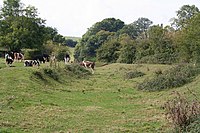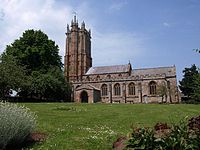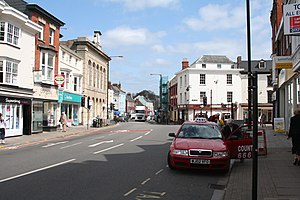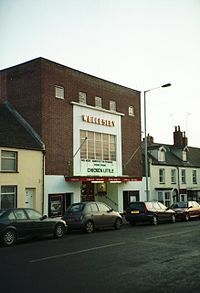Difference between revisions of "Wellington, Somerset"
(→Churches) |
m (→Churches: ioe -> nhle, replaced: {{IoE|269988 → {{NHLE|1176261, {{IoE|270011 → {{NHLE|1176369) |
||
| Line 49: | Line 49: | ||
*[[Church of England]]: | *[[Church of England]]: | ||
| − | **St John The Baptist<ref>{{ | + | **St John The Baptist<ref>{{NHLE|1176369|Church of St John The Baptist</ref> |
*Baptist: [http://www.wellingtonchurch.com/ Wellington Baptist Church] | *Baptist: [http://www.wellingtonchurch.com/ Wellington Baptist Church] | ||
*Independent Evangerlical: [http://www.kcwellington.org/ King's Church] | *Independent Evangerlical: [http://www.kcwellington.org/ King's Church] | ||
*Methodist: Wellington Methodist Church, on Waterloo Road | *Methodist: Wellington Methodist Church, on Waterloo Road | ||
*Presbyterian Independent Church - closed | *Presbyterian Independent Church - closed | ||
| − | *Quakers meeting house,<ref>{{ | + | *Quakers meeting house,<ref>{{NHLE|1176261|Friends' Meeting House}}</ref> |
*United Reformed Church: Wellington URC | *United Reformed Church: Wellington URC | ||
*Roman Catholic: St John Fisher | *Roman Catholic: St John Fisher | ||
Latest revision as of 11:05, 19 September 2019
| Wellington | |
| Somerset | |
|---|---|
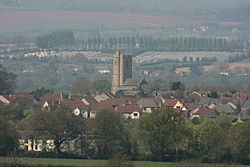 Wellington from Chelmsine | |
| Location | |
| Grid reference: | ST140203 |
| Location: | 50°58’32"N, 3°13’27"W |
| Data | |
| Population: | 13,696 |
| Post town: | Wellington |
| Postcode: | TA21 |
| Dialling code: | 01823 |
| Local Government | |
| Council: | Somerset West and Taunton |
| Parliamentary constituency: |
Taunton Deane |
Wellington is a small industrial town in rural Somerset, near the border with Devon (which runs along the Blackdown Hills to the south of the town) and more prosaically by the M5 motorway.
A town charter was granted to Wellington by King John in 1215 and during the Middle Ages it grew as a centre for trade on the road from Bristol to Exeter. Major rebuilding took place following a fire in the town in 1731, after which it became a centre for cloth-making. Today it has a population of about 13,696, which includes the residents of the parish of Wellington Without and the villages of Tone and Tonedale.
This is the town which giave a title to the Dukes of Wellington.
Local industries, which now include an aerosol]] factory and bed manufacturers, are celebrated at the Wellington Museum]] in Fore street. Wellington School, an independent school, is based here – well regarded if not quite as famous as Wellington College in Berkshire, though the latter is named after the Duke who was in turn named after this town.
The parish church is the 15th century Church of St John the Baptist.
Contents
Name
The town’s name is from the Old English Weolingtun, which appears to mean "wealthy estate",.[1] An alternative explanation for the origin of the name is "village in the temple clearing". It appears as Walintone in the Domesday Book of 1086.
Wellington gave its name to the first Duke of Wellington]], Arthur Wellesley, who is commemorated by the nearby Wellington Monument - the Iron Duke had an estate nearby.
History
In a grant of between 899 and 909, Edward the Elder, gave the land then known as Weolingtun, along with West Buckland and Bishops Lydeard to Bishop Asser in exchange for the monastery of Plympton in Devon.[2] By the time of the Domesday Book of 1086, Walintone was owned by Gisa (Bishop of Wells).[3]
A royal charter of 1215 gave Wellington its status as a town, and during the Middle Ages it grew as a centre for trade on the road from Bristol to Exeter, being laid out, with the church at the east end of town, in a similar manner to other towns of this era.[3] In 1548, the manor was sold to Edward Seymour, 1st Duke of Somerset, but reverted to the control of the bishops after his execution. By the end of the 16th century it had come under the protection of John Popham, the Lord Chief Justice, and his descendants who built a manor house which was destroyed during the Civil War.[3]
Major rebuilding took place in the town following a fire in 1731.[4] After this the town's importance grew as it became a centre for clothmaking across Somerset and Devon, its importance as trade centre enhanced by fires in Taunton and Tiverton.[3] By the 1831 census, 258 people were recorded as cloth workers in Wellington.[5]
In 1817, two years after his victory at the Battle of Waterloo, the foundation stone was laid for a monument to the Duke of Wellington which was completed only in 1854. It now stands on Wellington Hill above the town and is owned by the National Trust.
In the 18th century turnpikes arrived in the area and then in the 19th communications improved with the building of the Grand Western Canal, which reached the town in 1835, and then the Bristol and Exeter Railway.[3] Wellington station was opened when the line reached the town on 1 May 1843. It was a typical Brunel design but was rebuilt in 1932 when two loop lines were put in. This entailed the platforms being moved back to accommodate the widened lines. These platforms are clearly visible and a goods shed still stands on the east side of the line at the Taunton end of the station, although the station closed on 5 October 1964. Wellington was an important station as it stood at the foot of a steep incline. Banking locomotives were kept here, ready to assist heavy westbound trains up to Whiteball Tunnel.
In the 20th century closer links with Taunton meant that many of the residents of Wellington commuted there for work, and the M5 motorway, which opened in sections in the 1960s and 1970s,[6] enabled car journeys to be made more easily.[3]
Churches
Churches of the town were once in profusion and it is hardly bereft today. They include:
- Church of England:
- St John The Baptist[7]
- Baptist: Wellington Baptist Church
- Independent Evangerlical: King's Church
- Methodist: Wellington Methodist Church, on Waterloo Road
- Presbyterian Independent Church - closed
- Quakers meeting house,[8]
- United Reformed Church: Wellington URC
- Roman Catholic: St John Fisher
Economy
Wellington's main industry was wool-making and in November 2009 and it is still an important business: the Fox Brothers Mill weaves cloth for Savile Row, designers and clients around the world.
Local industries are celebrated at the Wellington Museum in Fore street. Wellington was home of Fox, Fowler and Company, which was the last commercial bank permitted to print their own sterling banknotes in England and Wales.[9][10]
The town is still largely dependent on industry, notably its aerosol factory. Swallowfield plc benefited from the growth of own-brand products during the 1970s and now produces aerosol, cosmetic and toiletry products. It was founded in 1876 as Walter Gregory & Co Ltd who manufactured animal husbandry products. The company diversified and in 1950 produced the first commercial aerosols in the UK which were basically farm products, air fresheners and insecticides.[11][12]
Bed manufacturers Relyon employ some 400 people. The company started in 1858 as a wool merchant, Price Brothers and Co., but the business soon moved into manufacturing beds and in 1935 changed its name to Relyon Ltd. In 2001 it was acquired by Steinhoff International Holdings Ltd., a quoted South African group.[13]
Culture
- Wellington Arts Association, including:
- Genesis Youth Theatre Group
- Operatic Society
- Pantomime Group
- Civic Players
- Arcadians
- Spectrum Arts And Crafts
- The Wellesley Cinema, built in 1937, in the traditional Art Deco style of that period.
- Wellington and District Camera Club
Media
- Wellington Weekly News
Transport links
The Grand Western Canal reached the town in 1835 and then the Bristol and Exeter Railway in 1843. The town's own railway station survived until 1964.
In the 20th century closer links with Taunton meant that many of the residents of Wellington commuted there for work, and the M5 motorway enabled car journeys to be made more easily.
Sport
- Cricket: Wellington Cricket
- Football: Wellington AFC
- Archery: Wellington Bowmen
- Rugby: Wellington RFC
Outside links
| ("Wikimedia Commons" has material about Wellington, Somerset) |
- The Somerset Urban Archaeological Survey: Wellington
References
- ↑ "Weolingtun". BirthVillage.com. http://www.birthvillage.com/Name/Weolingtun. Retrieved 6 June 2010.
- ↑ "Wellington's History". Wellington Town Council. http://www.wellingtontowncouncil.co.uk/freepage.asp?ID=2. Retrieved 3 May 2010.
- ↑ 3.0 3.1 3.2 3.3 3.4 3.5 Gathercole, Clare. "Wellington". English Heritage Extensive Urban Survey. Somerset County Council. http://www1.somerset.gov.uk/archives/hes/downloads/EUS_WellingtonText.pdf. Retrieved 3 May 2010.
- ↑ Havinden, Michael (1982). The Somerset Landscape. The making of the English landscape. London: Hodder and Stoughton. pp. 139. ISBN 0-340-20116-9.
- ↑ Dunning, Robert (2003). A history of Somerset. Tiverton: Somerset Books. p. 90. ISBN 0-86183-476-3.
- ↑ Charlesworth, George (1984). A History of British Motorways. London: Thomas Telford Ltd. ISBN 0-7277-0159-2.
- ↑ {{NHLE|1176369|Church of St John The Baptist
- ↑ National Heritage List 1176261: Friends' Meeting House
- ↑ Bank of England. "A brief history of banknotes". http://www.bankofengland.co.uk/banknotes/about/history.htm. Retrieved 8 October 2007.
- ↑ "Fox, Fowler & Co. £5 note". British Museum. http://www.britishmuseum.org/explore/highlights/highlight_objects/cm/f/fox,_fowler__co_%C2%A35_not.aspx. Retrieved 7 June 2010.
- ↑ "History". Swallowfield PLC. http://www.swallowfield.com/about/history.ashx. Retrieved 3 May 2010.
- ↑ "Testimonials". InvestInWellington.co.uk. http://www.investinwellington.co.uk/pages/testimonials.shtml. Retrieved 16 October 2007.
- ↑ "Relyon History". Relyon website. http://www.relyon.co.uk/index.php?option=com_content&view=article&id=144&Itemid=162. Retrieved 3 May 2010.
